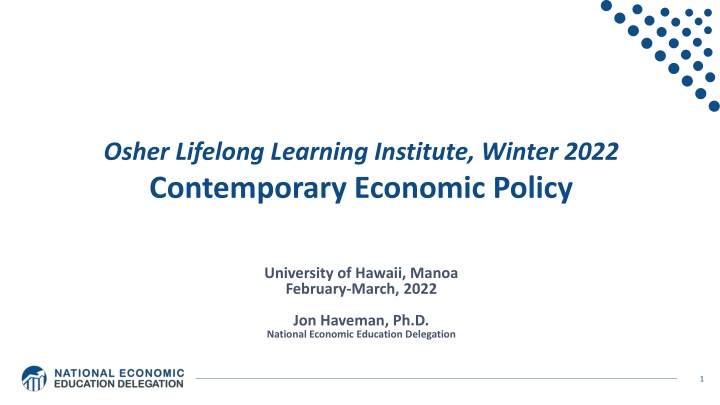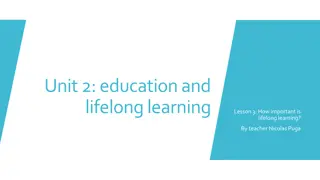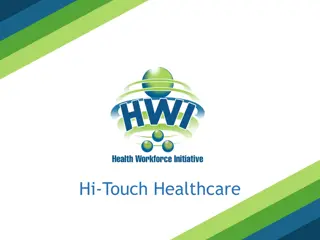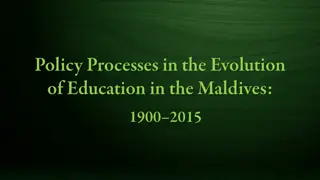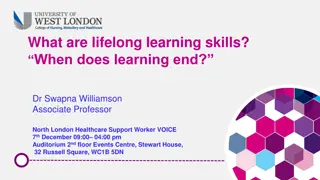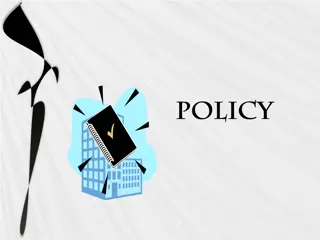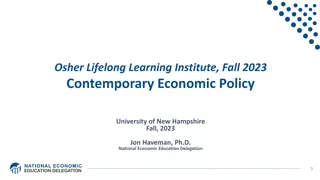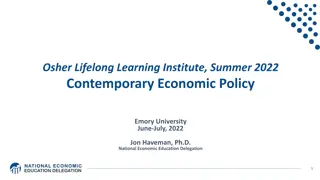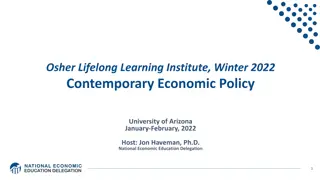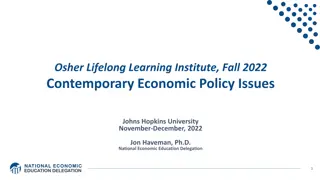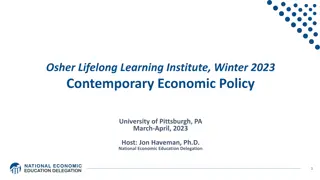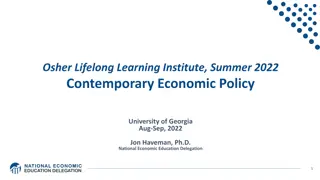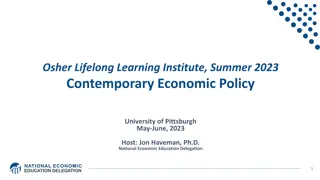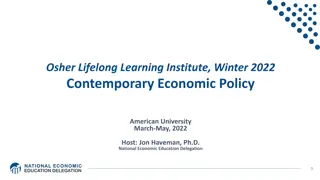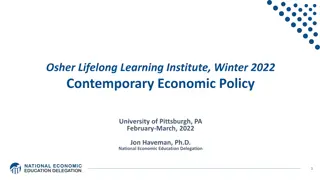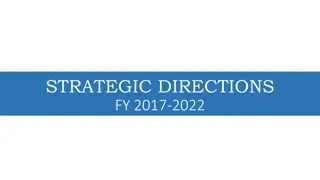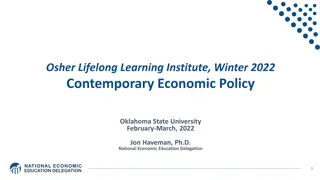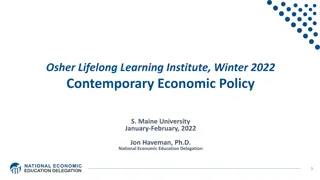Contemporary Economic Policy at Osher Lifelong Learning Institute
Explore the National Economic Education Delegation and its mission, engaging topics like US economy, climate change, economic inequality, and more. Dive into the course outline covering US economic updates, federal debt, discriminatory policies, and cryptocurrencies. Delve into pressing issues such as the federal debt concerns and climate change economics, including the impact on wine-growing regions worldwide. Discover a network of esteemed economists, including Nobel Prize winners, contributing to the public understanding of economic policy issues.
Download Presentation

Please find below an Image/Link to download the presentation.
The content on the website is provided AS IS for your information and personal use only. It may not be sold, licensed, or shared on other websites without obtaining consent from the author.If you encounter any issues during the download, it is possible that the publisher has removed the file from their server.
You are allowed to download the files provided on this website for personal or commercial use, subject to the condition that they are used lawfully. All files are the property of their respective owners.
The content on the website is provided AS IS for your information and personal use only. It may not be sold, licensed, or shared on other websites without obtaining consent from the author.
E N D
Presentation Transcript
Osher Lifelong Learning Institute, Winter 2022 Contemporary Economic Policy University of Hawaii, Manoa February-March, 2022 Jon Haveman, Ph.D. National Economic Education Delegation 1
National Economic Education Delegation Vision - One day, the public discussion of policy issues will be grounded in an accurate perception of the underlying economic principles and data. Mission - NEED unites the skills and knowledge of a vast network of professional economists to promote understanding of the economics of policy issues in the United States. NEED Presentations - Are nonpartisan and intended to reflect the consensus of the economics profession. 2
Who Are We? Honorary Board: 54 members - 2 Fed Chairs: Janet Yellen, Ben Bernanke - 6 Chairs Council of Economic Advisers o Furman (D), Rosen (R), Bernanke (R), Yellen (D), Tyson (D), Goolsbee (D) - 3 Nobel Prize Winners o Akerlof, Smith, Maskin Delegates: 649+ members - At all levels of academia and some in government service - All have a Ph.D. in economics - Crowdsource slide decks - Give presentations Global Partners: 48 Ph.D. Economists - Aid in slide deck development 3
Available NEED Topics Include: Coronavirus Economics Immigration Economics US Economy Housing Policy Climate Change Federal Budgets Economic Inequality Federal Debt Economic Mobility Black-White Wealth Gap Trade and Globalization Autonomous Vehicles Minimum Wages US Social Policy 5
Course Outline Contemporary Economic Policy - Week 1 (6/30): US Economic Update - Week 2 (7/7): The U.S. Federal Debt (Geoffrey Woglom, Amherst College) - Week 3 (7/14): Climate Change - Week 4 (7/21): Economic Inequality - Week 5 (8/4): The Black-White Wealth Gap - Week 6 (8/11): Discriminatory Policies - Week 7 (8/18): Cryptocurrencies 6
Climate Change Economics The changing map of the world s wine-growing regions. 8
National Income Inequality: Share of Top 10% Stock Market Crash WWII Housing Bubble Dot-com Bubble 9
Evidence of the B-W Wealth Gap Mean is 7x Greater Median is 8x Greater 10
Misguided Past Policies: Redlining Red areas were largely Black communities, and considered to be too risky for new home loans. Yellow areas also suffered from discrimination resulting from FHA guidelines.
Bitcoins: What is the Excitement About? Almost 500% increase in 6 months Blue Line Price of Bitcoin Red Line: Price of Gold On, 12/9, 1PM 1 bitcoin = $48k 12
Credits and Disclaimer This slide deck was authored by: - Jon D. Haveman, NEED - Scott Baier, Clemson University - Geoffrey Woglom, Amherst College (Emeritus) - Brian Dombeck, Lewis & Clark College - Doris Geide-Stevenson, Weber State Disclaimer - NEED presentations are designed to be nonpartisan. - It is, however, inevitable that the presenter will be asked for and will provide their own views. - Such views are those of the presenter and not necessarily those of the National Economic Education Delegation (NEED). 14
Submitting Questions Please submit questions in the chat. - I will try to handle them as they come up, but may take them in a bunch as time permits. We will do a verbal Q&A once the material has been presented. - And the questions in the chat have been addressed. 15
Outline State of the pandemic The U.S. Economy Hot Topics - Government policy - Inflation 16
Making Real ProgressUntil Omicron Nationally 18 Source: NYTimes
Making Real ProgressUntil Omicron Georgia 19 Source: NYTimes
Some Basic Statistics Statistic: Value Population 332.9 Million Labor Force (age 16+) 164.4 Million Employment (Nonfarm) 151.7 Million Gross Domestic Product (GDP) $24.4 Trillion Income per Capita $63,884 Ave. Hourly Earnings $31.95 21
U.S. Economy in Global Perspective U.S. Nominal GDP: $21.747 trillion in 2019-Q4 $19.487 trillion in 2020-Q2 $24.383 trillion in 2022-Q1 22
Composition of the U.S. Economy: GDP 23 Note: Does not add to 100% because of omitted sectors.
Composition of the U.S. Economy: Employment Manufacturing GDP Share = 10.9% Health GDP Share = 7.4% 24 Note: Does not add to 100% because of omitted sectors.
DeKalb County GSP: Manuf, Finance, Science 25 Note: Does not add to 100% because of omitted sectors.
DeKalb County Employment: Health 26 Note: Does not add to 100% because of omitted sectors.
GDP Relative to Long-Term Trends Gap: 11% or $5,000 per person 11% 30
GDP Trajectory: Pandemic Plunge! Q3 - Flat GDP is: - $0.5 Trillion Below 2019 forecast. - $0.6 Trillion ABOVE 2019-Q4 level. 31
Spending Patterns Since First US Case Q1 - Wobbly Q3 - Flat 32 Source: https://tracktherecovery.org/
Spending Patterns Hardest Hit Sectors +0.2% Transportation 34 Source: https://tracktherecovery.org/
V-Shaped Recovery Labor Market 2.00 Months since the start of the recession 0.00 -5 -1 3 7 11 15 19 23 27 31 35 39 43 47 51 55 59 -2.00 -4.00 -6.00 -8.00 -10.00 -12.00 -14.00 -16.00 Great Recession Pandemic Source: Bureau of Labor Statistics (BLS)
Employment Gap 0.8 Million below February, 2020. 6.7 Million below where we should be. 38
Employment Gap In Historical Perspective 18.8 Million below where we should be. 39
Trends in Labor Force Participation Down 3.8 million 43
Hot Topics Government policy Inflation 46
What Have Been Policy Effects? MONETARY POLICY (Fed) acted quickly and effectively to prevent a financial market meltdown and to keep credit flowing. But the Fed lends and does not spend. FISCAL POLICY (Congress) acted quickly, but inevitably made some mistakes. - Stimulus Checks, A ($268b) - Expanded Unemployment, B ($268b) - Paycheck Protection Program, C- ($525b) 47
Abnormally High Savings Biden Boost Trump Bump CARES 48
Monetary Policy: Federal Reserve Primary goal is to keep interest rates low, to facilitate continued borrowing. - Federal Funds Rate rate at which banks lend to each other, usually overnight. - Purchases of U.S. Treasury securities keep money flowing to the government at low rates of interest. 49
